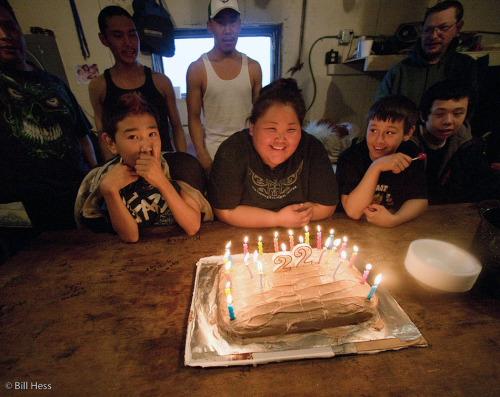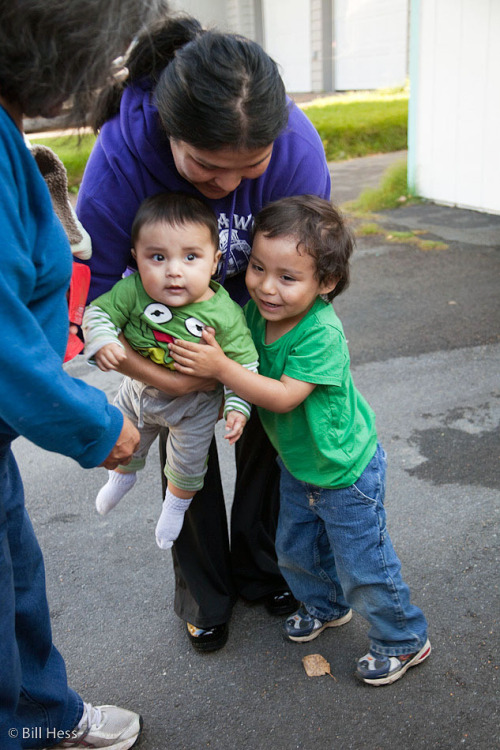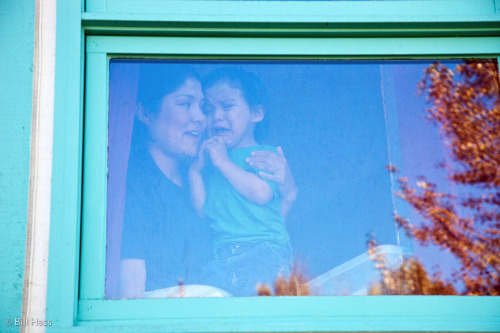 Many of their peers have since passed on, but here are a few of those who founded and helped to organize the North Slope Borough: the late Walter Nayakik of Wainwright, founder, represented by his son, Jimmy Nayakik; Frank Matumeak, of Nuiqsut, founder; Lloyd Ahvakana of Barrow, first Finance Director; Jon Buchholdt of Anchorage, special assistant to Eben Hopson, first Mayor; Billy Nashoalook of Wainwright, founder; the late Roosevelt Paneak of Anaktuvuk Pass, founder, represented by his son, Bruce; Fenton Rexford of Kaktovik, founder. Mayor Hopson is pictured in the painting that hangs on the wall behind them.
Many of their peers have since passed on, but here are a few of those who founded and helped to organize the North Slope Borough: the late Walter Nayakik of Wainwright, founder, represented by his son, Jimmy Nayakik; Frank Matumeak, of Nuiqsut, founder; Lloyd Ahvakana of Barrow, first Finance Director; Jon Buchholdt of Anchorage, special assistant to Eben Hopson, first Mayor; Billy Nashoalook of Wainwright, founder; the late Roosevelt Paneak of Anaktuvuk Pass, founder, represented by his son, Bruce; Fenton Rexford of Kaktovik, founder. Mayor Hopson is pictured in the painting that hangs on the wall behind them.
After oil was discovered at Prudhoe Bay in 1968, the oil companies and the State of Alaska began to negotiate between themselves on how to divvy up the wealth and royalties that would soon be pulled from the Iñupiat Arctic Slope homeland and shipped south through the Trans-Alaska Pipeline. They completely left the Iñupiat out of the equation.
The Iñupiat were the original owners of not only Prudhoe Bay but the entire Arctic Slope and all the wealth within it and they had never agreed to surrender or sell any of it. When the Alaska Native Land Claims Settlement Act (ANCSA) was passed in 1971, Joe Upicksoun, the Arctic Slope representative, shouted out a thunderous "No!" when asked for his peoples' vote on whether or not to accept ANCSA as written.
 Billy Nashoalook of Wainwright, Founder.
Billy Nashoalook of Wainwright, Founder.
Still, without Iñupiat consent, the act passed. As far as the State, the Feds and the oil companies were concerned, the $1 billion that would be paid to the 13 Alaska Native regional corporations and over 220 village corporations that were to be formed across the state, was compensation enough.
It was also argued that all of Alaska's Natives had also been "given" 44 million of the 375 million acres that had sustained them and been their's under aboriginal title since time immemorial and that this was enough.
The Iñupiat did not see it that way. In a single day's lease sale at Prudhoe Bay, the oil companies had paid $1 billion for the right to explore for oil - because they knew that from that $1 billion, they would reap billions upon billions upon billions. This single day's lease take equalled the entire sum paid to all the Alaska Native nations - not just the Iñupiat, but the Tlingit and Haida, Athabascan, Aleut, Yup'ik and every Alaska Native - for the 330 million acres of their traditional homelands that they would not be allowed to claim.
 Frank Matumeak is congratulated by Mayor Edward Itta and Assembly President Eugene Brower.
Frank Matumeak is congratulated by Mayor Edward Itta and Assembly President Eugene Brower.
The Iñupiat believed that if oil from their traditional lands was going to generate wealth to benefit the entire United States, a substantial portion of that wealth should be directed back to the Slope to benefit the people there.
Also, they felt that if there was going to be development in the Iñupiat homeland, the Iñupiat must have planning and zoning powers in order to protect environmentally sensitive places important to the animals, fish and birds that sustained them.
And so they determined that they would organize the strongest form of Borough government allowed under state law - one that would give them powers of taxation, planning and zoning. While that government would not receive royalties from oil development at Prudhoe Bay and nearby fields, it would be able to tax the property and physical structures of the oil companies - everything from pipelines to wells to housing quarters.
This would provide the funds needed to improve housing, build schools, medical facilties, power plants, water and sewer facilities, police deparments - the kinds of services that most Americans took for granted, but that scantly existed on the North Slope.
 Fenton Rexford, Founder.
Fenton Rexford, Founder.
The Borough did organize and Eben Hopson, one of the men who led the push, was voted in as first Mayor. He is revered across the Slope and his achievements and legacy are highly honored among the Iñupiat. There were many others who played critical roles in that push, from the Reverend Samuel Simmonds to Charlie Edwardsen, Jr.
Many meetings and gatherings were held in all eight Slope village in the process of organizing the North Slope Borough and those individuals who did the organizing and signed the charter document are now known as the founders. Three who still live, along with the sons of two who are deceased, were honored in person for their achievement by Borough Mayor Edward Itta and the NSB Assembly at last week's assembly meeting.
The original founders present included Frank Matumeak of Nuiqsut, Billy Nashoalook of Wainwright and Fenton Rexford of Kaktovik. The late Roosevelt Paneak of Anaktuvuk Pass was represented by his son, Bruce, and the late Walter Nayakik of Wainwright by his son, Jimmy.
 Jon Buccholdt. The ivory eagle on the table beside him was given to Buccholdt as a gift from Charlie Hopson, son of Eben Hopson, first mayor of the Borough.
Jon Buccholdt. The ivory eagle on the table beside him was given to Buccholdt as a gift from Charlie Hopson, son of Eben Hopson, first mayor of the Borough.
Also honored was Lloyd Ahvakana, the Borough's first finance director and a close confidant and advisor to Hopson and Jon Buchholdt, special assistant to Eben Hopson, an attorney famed for his ability to innovate and to help advance Borough issues in the face of powerful and often hostile opponents.
While the journey has often been a rough one, on the whole the North Slope Borough has been remarkably successful. In every village there are modern, well-equipped schools, fire-stations, power plants, utilities, clinics, police stations, roads and maintenance and other facilities.
 Lloyd Ahvakana, the Borough's first finance director.
Lloyd Ahvakana, the Borough's first finance director.
Even so, subsistence hunting remains the primary source of sustenance for most of the Borough's Native people and even many of its non-Native residents. The Borough has stood up for subsistence rights, including the financial support it has given the Alaska Eskimo Whaling Commission in the fight to protect the bowhead whale hunt from a world that once sought to shut it down.
It has a wildlife department that funds and coordinates wildlife science to provide hard data on the health of Arctic animals.
"The Borough has been a fighting force for us," Matumeak said. He recalled that during the process that led to its founding, there were many worrying moments. Unlike a tribe, the Borough would not be a Native government, per se. Would outside forces work their way in and take the power away from the Iñupiat?
That has not happened, Matumeak says. He points with pride to the schools and other facilities that can be found in every village. He still would like to see more of the jobs that go to newcomers filled by Iñupiat and is positive that the Iñupiat can successfully do those jobs.

The three original founders who were honored in person: Frank Matumeak, Billy Nashoalook and Fenton Rexford. Rexford serves on the Assembly.

Billy Nashoalook recalled a moment of high drama in the organization process. He and others were flying back to Barrow after a village meeting in the red airplane with the flat tires when the landing gear got stuck in the up position. As their fuel neared empty and the time to land became imminent, the pilot finally managed to crank the gear down by hand.
 Friday, September 17, 2010 at 3:20PM
Friday, September 17, 2010 at 3:20PM 













